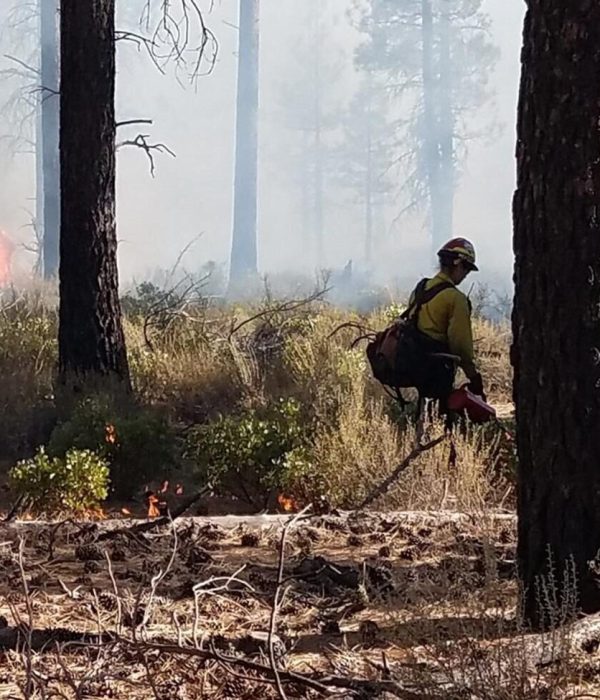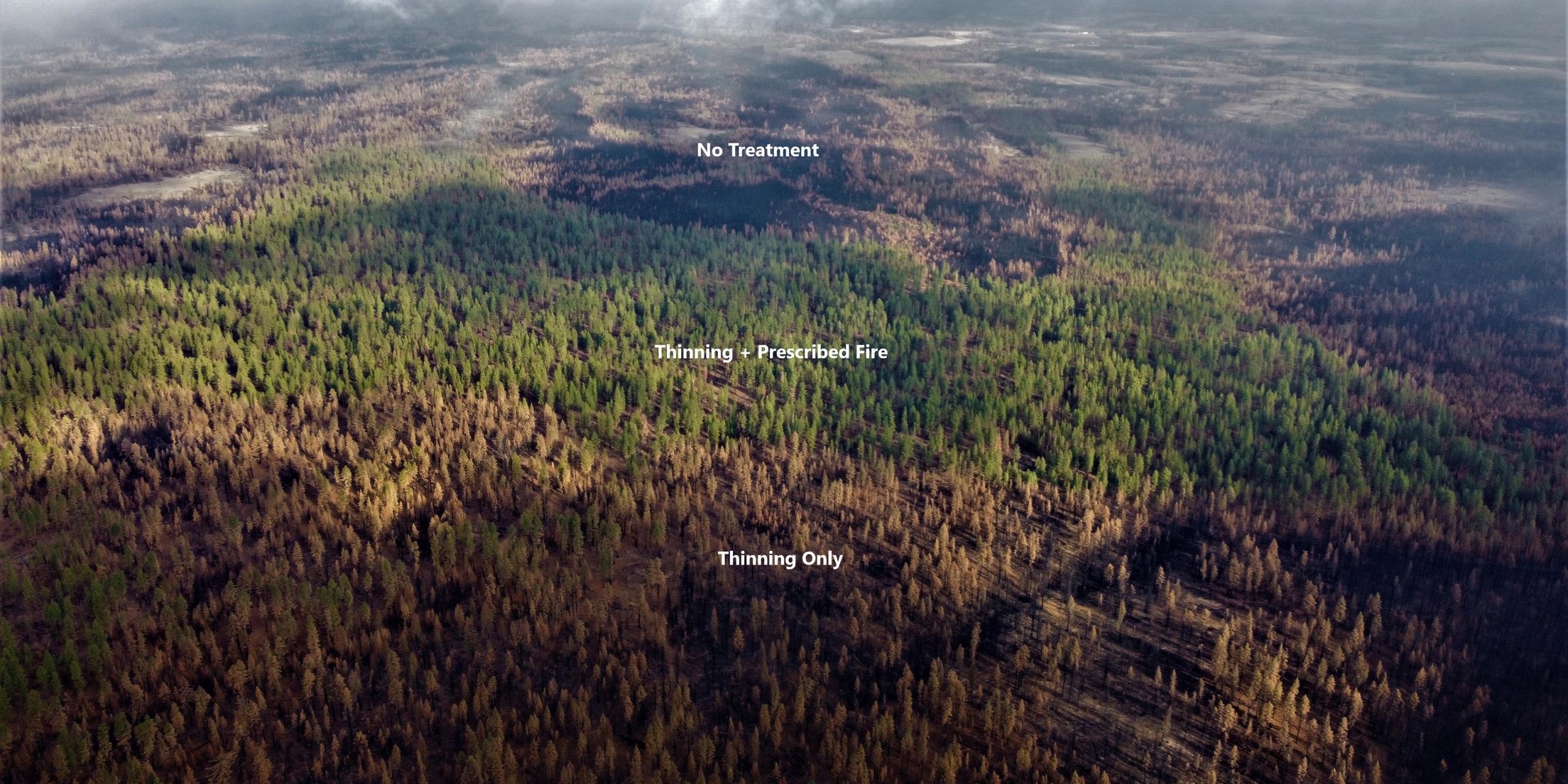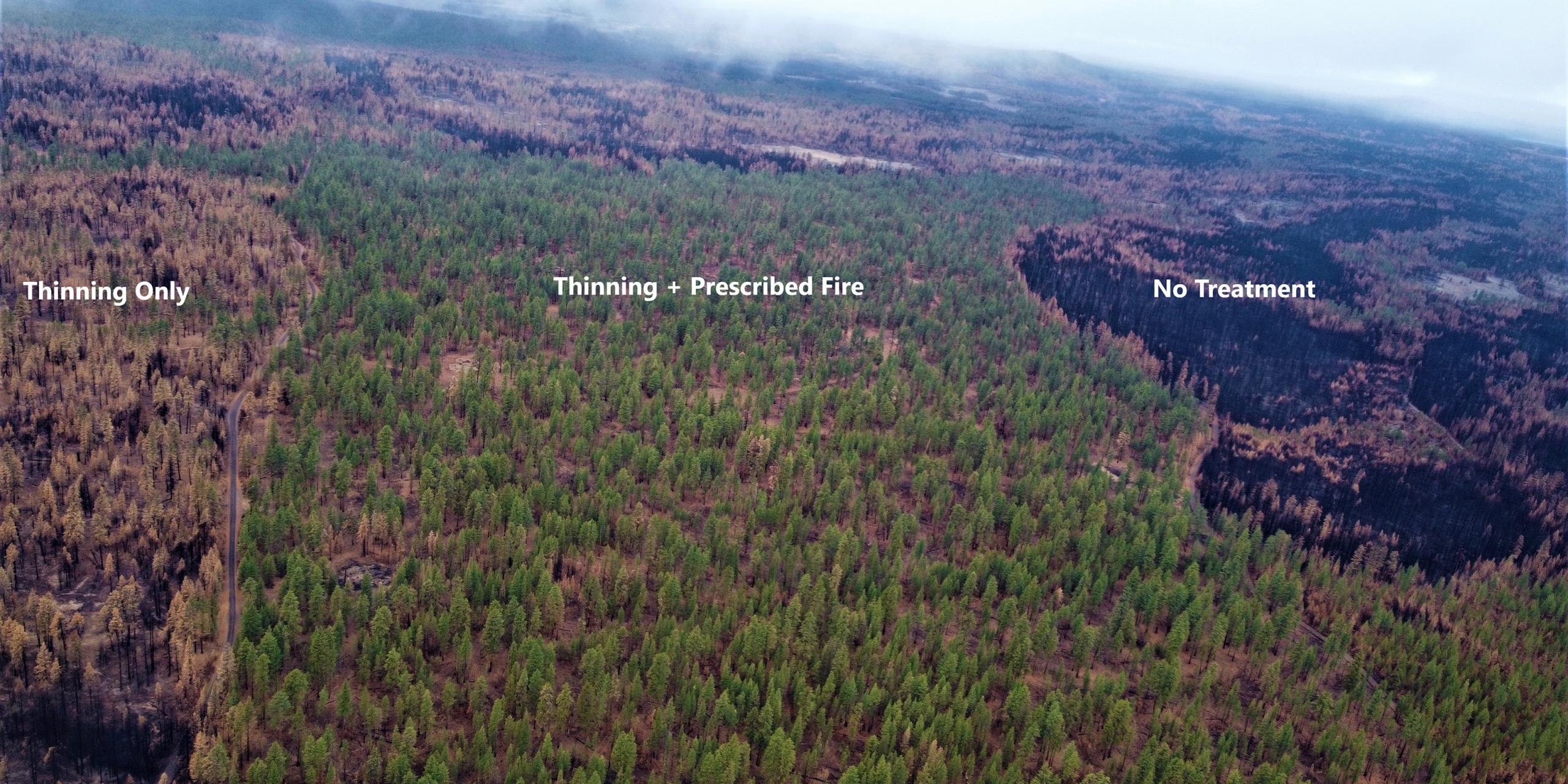
Director of the Indigenous Leadership Program
Gabe Sheoships holding a lamprey eel. Photo credit: Jeremy Monroe, Freshwaters Illustrated
Gabe Sheoships (Cayuse/Walla Walla) is the executive director of Friends of Tryon Creek, the nonprofit arm of Tryon Creek State Natural Area in Portland, Ore. Its mission is “to inspire every community to identify, cultivate, or reclaim their relationship with nature in this cherished urban forest.”
In this interview, Gabe talks with Ecotrust staff Emilie Chen, Jessica Douglas, Brent Davies, and Lisa Watt about the impacts of climate change on forest and ecosystem health, the benefits of conducting cultural or controlled burns, and the importance of Indigenous-led stewardship efforts that reconnect tribes to land, support tribal cultures, and ultimately benefit everyone.
This interview was conducted through a partnership with the Bonneville Environmental Foundation with funding provided by the Climate Resilience Fund for the Treeline Project. It was first published in the February issue of the Treeline newsletter.
In general, people are afraid of fire on the landscape but not Indigenous peoples. Tribes have used fire as a tool since time immemorial. Why, how, and when was fire used?
The Pacific Northwest tribes I’m familiar with were conducting controlled cultural burns a good portion of the year before settler contact. As an example, the mountains that we frequented like Mount Adams in southern Washington had fires started by lightning and other natural elements but those lands were also stewarded by tribes setting controlled fires in the fall and spring.
Tribes know fire has always played an important role in fostering healthy ecosystems, forests, and streams. It’s been an important tool to restore the landscape, burn back weeds and brush, promote Native plants, berries, and roots, and build healthy soils. It’s also used in some areas to cultivate old growth cedar for carbon and procurements. So, fire has an intact relationship with North America or Turtle Island, but it’s been suppressed for 150 years or so.

Through the Fire Learning Network (FLN), a joint project with the Lomakatsi Restoration Project, The Nature Conservancy, and Bureau of Land Management with participants from a variety of agencies and cooperators, students gather to learn from each other and share expertise in prescribed fire management Photo credit: Lisa McNee, BLM
What happened to the landscape when cultural or controlled burning was stopped?
Cultural burning stopped around the same time as the introduction of noxious, non-native plants by European settlers, who brought them here for cultivation or botanical uses, plants like English ivy and Himalayan blackberry. The lack of fire built up forest fuels but it was also the time of peak logging and clearcutting in the Northwest which released carbon into the ecosystem and air.
It’s the arc of colonization, frankly, from the removal of Native peoples from our lands and subduing our traditional stewardship to promoting livestock grazing, forest clearcuts and damming rivers. Forests became viewed and managed more like a crop rather than a living, functioning ecosystem. It’s an ecosystem shock.
What are some of the cultural benefits of traditional burning for tribal people?
Just the act of returning fire to traditional places is restoring Indigenous relationships to fire. It’s about the reclaiming, reconnecting, re-stewarding of Indigenous lands. Fire is part of larger cultural movements that promote intact, healthy forests and First Foods such as fish, game, roots, and berries, while building fire resilience in our modern communities and forest systems and restoring important parts of our ecosystems that have been without fire for so long.
Cultural burning and tribes have received a lot of attention after the wildfires in the west over the last couple of years. What does that say?
It says, nothing gets people talking or thinking more than when their own safety is threatened. 2020 was the perfect storm of high winds and temperatures and severe droughts that fueled the fires we saw in Clackamas, Multnomah Counties, including the greater Portland metropolitan area, and other places. These perfect storms happened in other places, too, like California where wildfires devastated homes, communities, and cost lives. And with climate change, along with several converging ecological factors, the frequency of these intense and aggressive wildfires will only increase until more Indigenous stewardship of these lands is returned.
To me, one of the most important takeaways is that tribes still practice controlled fire and some conduct seasonal fires. Where tribes conducted cultural burns, there wasn’t the level of intense wildfires because the landscape was tended to and had become more resilient. Burns led by tribes were conducted safely, which created a succession of fire resilient forests. I think that’s still one of the biggest educational pieces – tribes have a lot of experience doing this. We only need to look at what’s happened to landscapes and forests that have gone without it.

When the Bootleg Fire raged throughout southern Oregon and approached the Black Hills Ecosystem Restoration Project, an area where the Klamath Tribes worked with the US Forest Service to thin young trees and apply prescribed burning, the forest was far less damaged than other areas that were not treated. Photo credit: Steve Rondeau, Klamath Tribes
What does it look like for tribes to be able to fully reclaim fire stewardship? What are all of the elements that would need to be in place?
Tribes have to be in positions to lead cultural burns, which includes leading the planning processes that create and inform long-term management and stewardship that incorporates burning, planting, and tending. Most of our forestlands are still in state, federal, and other hands that are less likely to bring traditional burning and fire stewardship back. Tribes have important seasonal knowledge, long-term observations, and Traditional Ecological Knowledge (TEK) that provide a different kind of management, much different than some wildland tactics or just burning your excess or dead wood.
“
I think these agencies need to partner more or, in some places, give lands back to tribes to co-manage or co-steward, or both in certain areas.
Here in Oregon, the Forest Service and Bureau of Land Management manage most of the culturally important, intact lands. I think these agencies need to partner more or, in some places, give lands back to tribes to co-manage or co-steward, or both in certain areas. Tribes can then create and implement plans that bring back fire annually or biannually, and develop plans that address all the converging factors that enable climate change. Those plans could be seasonal but they would also have a much longer timeframe, 10 or 20 years or more.
Those recent fires were terrifying. We know what the answer is—it’s better stewardship of forests and lands. But we’re not doing it. What do you think keeps us from doing what we should be doing to be responsible to the land?
I think government agencies are afraid to give up power and face the unknown. It’s a western sense of ownership. Indigenous-led cultural burns could well advance a bigger, broader cause that would ultimately benefit them and everyone else. But for folks that have been in power for so long, all of this is new. Who wants to give up power? Also, the Forest Service, which is the largest landowner in the state, logs and sells commercial timber; staff might see cultural burns as burning up profits.
Indigenous stewardship would benefit everybody as well as our ecosystems, First Foods, and keystone species like salmon. Recently, there have been western scientific articles devoted to developing a relationship with fire in a different way. But those articles say what our TEK and our elders have been saying all along, that fire has an important place on this landscape and is effective in stewarding these lands. It’s just a different way of looking at the ecosystem.
How is climate change impacting the landscape and our forests now?
Just the act of returning fire to traditional places is restoring Indigenous relationships to fire. It’s about the reclaiming, reconnecting, re-stewarding of Indigenous lands. Fire is part of larger cultural movements that promote intact, healthy forests and First Foods such as fish, game, roots, and berries, while building fire resilience in our modern communities and forest systems and restoring important parts of our ecosystems that have been without fire for so long.
“
All these issues are going to put more pressure on our complex ecosystems issues.
With climate change, we can expect to see more droughts and higher temperatures like this past summer on the West Coast where it was 115 and 116 degrees in Portland, Ore., creating more dry, fire-ready, uncontrolled fire conditions. This intense heat wave cost human and aquatic species losses. We’ll see snow melting faster and we’ll see water temperatures getting warmer more quickly each spring. We’ll see certain types of beetles and other insect predators that are harmful to our native trees, plants, and animals. In eastern Oregon today, there are several viruses related to heat-induced drought that have been spreading disease within deer populations through vectors such as gnats (epizootic hemorrhagic disease and bluetongue disease). We’ll see more of the rapid and intense wildfires that we’ve witnessed recently, which create poor air quality and harm all living things and people.
All these issues are going to put more pressure on our complex ecosystems issues. It’s almost like death by 1,000 cuts to the ecosystem, as a former mentor of mine often put it.

The Klamath Tribes worked with the US Forest Service to apply prescribed burning at the Black Hills Ecosystem Restoration Project. The fire treatment lead to a less damaged forest when the Bootleg Fire raged throughout southern Oregon. Photo credit: Steve Rondeau, Klamath Tribes
Many cultural burns take place in rural areas now but you see the benefit of having controlled cultural burns near or in urban forests as well. What would be some of the challenges that would need to be overcome to do a traditional burn in an urban setting?
We are in the infancy of thinking about what a traditional or cultural burn could look like in urban environments, but, yes, it is something we’d like to see happen since urban forests need help as well.
To do so, there would have to be a lot of education in the nearby communities since there are still many people who are afraid of fire or associate all fires with the intense and devastating wildfires we’ve witnessed in recent years. Part of that education would be showing how good fire can create fire resiliency and actually protect and stabilize neighborhoods. We would want an initiative to be Indigenous-led and partner with nearby tribes and tribal people to promote cultural fire training and pilot a few different sites. We would also enlist specialists like Dr. Frank Lake (Karuk/Yurok), who is a research ecologist with the Forest Service and an expert on Indigenous fire stewardship. And we would have to work through appropriate channels in partnership with Oregon State Parks.
Our hopes for this type of project are that cultural burning would benefit the entire community by creating ecosystem resilience and returning fire to the landscape in an Indigenous-led program that would hopefully extend throughout the Metro area.
What are some of the opportunities you see with the reintroduction of an urban-based cultural burn?
There are many educational opportunities. For instance, students of all ages and backgrounds could examine an ecosystem pre- and post-fire and monitor changes that occur over the long term, witnessing the traditional stewardship that has always taken place on these lands. In our work, we also promote First Foods stewardship through food plants such as salmonberry, Oregon grape, thimbleberry, elderberry, stinging nettle, and students could monitor their re-establishment and succession.
“
Burning is a cultural act, it’s about cultural knowledge and identity of place.
What are some of the cultural benefits of traditional burning for tribal people?
The ecological benefits include creating fire resilience by control burning much of the slack or brush and noxious plants. Even in places that have been well stewarded in the lower Willamette River Basin there’s still a lot of English ivy, Himalayan blackberry, and other noxious plants that are well established. The use of controlled fire would inform an effective, long-term management plan that could complement a lot of the hand pulling or removal of noxious plants.
If people are able to see the benefits, which is obviously not going to happen overnight, they will then look at the long-term benefits of controlled fire within an urban/rural landscape. It would ultimately bring about lessons for other urban areas to be stewarded and reconnect cultural fire in a good way.
We know cultural practices are lost across generations; they’re often lost for entire families, bands, and tribes. An initiative like this, which could connect nearby tribes and be Indigenous-led, would be an important step in reconnecting and restoring cultural knowledge for current and future generations. As younger people get interested and lead efforts like these, it bolsters our communities to teach and promote this practice to more Indigenous peoples and their children.
Burning is a cultural act, it’s about cultural knowledge and identity of place. So connecting as the Indigenous stewards of this landscape will have a greater effect in promoting First Foods, cultural fire, and Indigenous stewardship throughout our region.
Thank you, Gabe.
An enrolled citizen of the Confederated Tribes of the Umatilla Indian Reservation, Gabe Sheoships is the Executive Director of Friends of Tryon Creek, where he leads efforts for community building, environmental stewardship, and protection of the natural world. He has dedicated his life’s work to protecting Indigenous First Foods, encouraging healthy ecosystems, and empowering people to act as stewards of the land and water. He serves as board co-chair of Nesika Wilamut (formerly Willamette River Network), board president of the Tributaries Network, and board member of Center for Diversity and the Environment and Freshwaters Illustrated. As an adjunct professor at Portland State University, he instructs students in the Indigenous Nations Studies Program, Environmental Science and Management, and University Studies departments. Gabe has an MSc in Fisheries Biology from Oregon State University.

BLOG
INTERVIEW | An interview with Cody Desautel about the impacts of climate change on the Tribes’ forest and economy and how they are responding to threats

BLOG
INTERVIEW | | An interview with Mike Durglo, Jr., the Tribal Historic Preservation Office director for the Confederated Salish and Kootenai Tribes